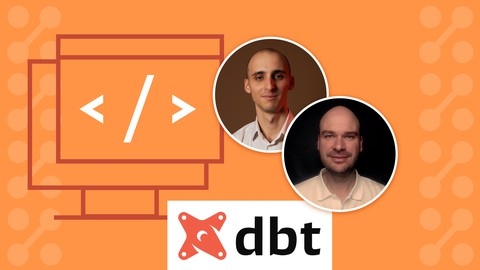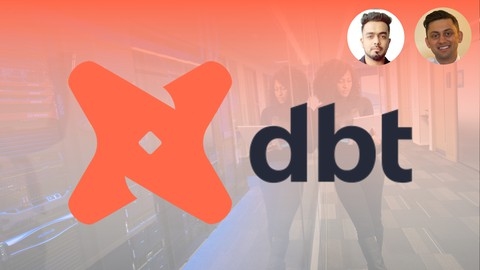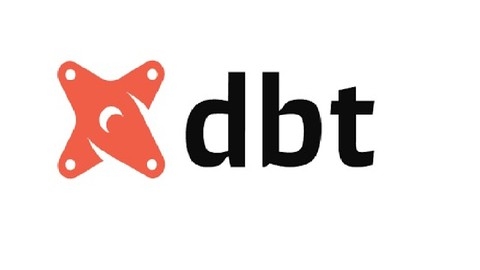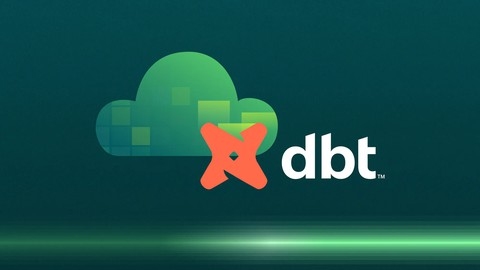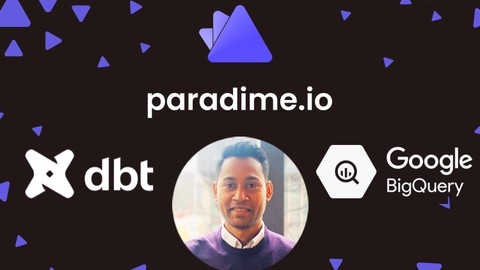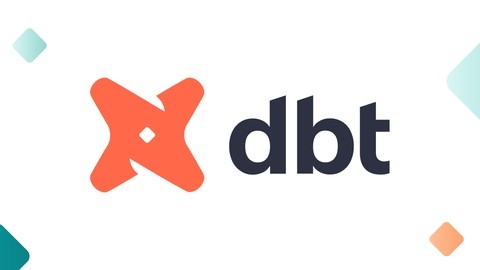dbt, or Data Build Tool, is a powerful open-source tool that revolutionizes the way data engineers and analysts transform and model data.
It allows you to define your data transformations in a modular, reusable, and testable way, making your data pipelines more efficient, reliable, and maintainable.
By mastering dbt, you can build robust data models, ensure data quality, and streamline your data workflows, leading to more informed business decisions.
Finding the right dbt course on Udemy can be challenging, as there are countless options available.
You might be looking for a course that’s comprehensive, practical, and taught by experienced professionals who can guide you through the complexities of dbt.
You want a course that goes beyond theory, providing hands-on projects and real-world examples to solidify your understanding.
We’ve carefully reviewed numerous dbt courses on Udemy and have identified The Complete dbt (Data Build Tool) Bootcamp: Zero to Hero as the best overall course.
This comprehensive bootcamp covers all aspects of dbt, from the basics to advanced concepts, and includes numerous practical exercises and projects to solidify your understanding.
The instructor is a seasoned dbt expert who provides clear explanations and engaging lessons.
While The Complete dbt (Data Build Tool) Bootcamp: Zero to Hero is our top pick, there are other fantastic options available on Udemy.
Keep reading to explore our recommendations for different learning styles and goals, including courses for beginners, intermediate learners, and those seeking to master specific dbt features and functionalities.
The Complete dbt (Data Build Tool) Bootcamp: Zero to Hero
The course provides a comprehensive introduction to dbt (Data Build Tool), covering both theoretical concepts and hands-on practical sessions.
You’ll start by learning about the data maturity model, data warehouses, data lakes, and the modern data stack.
This lays the foundation for understanding the role of dbt in the data engineering ecosystem.
Next, you’ll dive into the core dbt concepts like models, materializations, seeds, sources, snapshots, tests, macros, and documentation.
The course uses an Airbnb dataset as a practical use case, guiding you through setting up dbt with Snowflake and creating your first dbt project.
You’ll learn how to write models, configure materializations, work with seeds and sources, create snapshots for historical data, and implement tests to ensure data quality.
One of the highlights is learning about slowly changing dimensions (SCD), a crucial concept in data warehousing.
The course covers different SCD types and how to handle them with dbt.
The course also covers advanced topics like writing custom macros, creating custom tests, and integrating third-party packages.
You’ll learn how to generate comprehensive documentation, including data lineage graphs, using dbt’s built-in documentation features.
Additionally, you’ll explore analyses, hooks, and exposures, which allow you to create custom analyses, execute code before or after model runs, and expose models to BI tools, respectively.
The course introduces debugging techniques, including using dbt’s logging capabilities and the dbt-expectations package for advanced data testing.
You’ll learn how to work with variables, making your dbt models more flexible and production-ready.
To streamline the development process, the course covers using the dbt Power User extension for VSCode and orchestrating dbt with Dagster, a popular data orchestration tool.
The course also touches on using AI for generating documentation, creating models from SQL or source definitions, interpreting queries with explanations, and performing health checks on your dbt project.
Finally, you’ll get insights from industry experts on best practices for introducing and using dbt in your company, as well as guidance on preparing for the dbt certification exam.
Learn DBT from Scratch
This course is an introduction to dbt (data build tool) and its integration with Snowflake.
You will learn how to connect your dbt account to Snowflake and start querying data.
The course covers the fundamentals of dbt models and tests, including different types of materializations, tables, views, incremental models, and ephemeral models.
You will gain an in-depth understanding of advanced configurations, testing, and creating custom tests.
The course also covers deploying models using the command line and setting up dbt Cloud.
Additionally, you will explore advanced topics such as hooks, snapshots, sources, and macros.
The course emphasizes best practices, including environment setup, styling with common table expressions, using tags, limiting data, and continuous integration with Github.
By the end of this course, you will have a solid foundation in dbt and be able to effectively manage and transform data in Snowflake using dbt.
The Data Bootcamp: Transform your Data using dbt™
You’ll begin by understanding what dbt is and how it differs from traditional ETL processes.
The course then guides you through setting up the necessary tools like dbt Cloud, a Snowflake data warehouse, and connecting to a Github repository.
Once the setup is complete, you’ll dive into the core concepts of dbt.
You’ll learn how to develop models, work with modular code using ref functions, and configure dbt projects using YML files.
The course also covers essential topics like testing data models, generating documentation, and using powerful features like macros, packages, and seeds.
A key strength of this course is its hands-on approach.
You’ll not only learn the theory but also get practical experience by working on a real-world project brief.
This will help you understand how to apply dbt in a production environment.
The course also introduces you to JINJA, a templating language used extensively in dbt.
You’ll learn how to leverage JINJA to create dynamic and reusable code.
Throughout the course, you’ll gain a solid understanding of dbt’s deployment process, ensuring you can confidently deploy your data models to production.
2024 Mastering dbt (Data Build Tool) - From Beginner to Pro
You’ll start by learning the basics of dbt and its role in the modern data stack.
The course covers the benefits of using dbt, such as inferring dependencies, documentation, testing, and Python-like functionality.
You’ll get hands-on experience setting up the necessary tools, including creating a Gmail account, setting up a BigQuery project, installing Python and VSCode, and creating a GitHub account.
The course walks you through forking a repository, setting up a virtual environment, and installing packages.
Once the setup is complete, you’ll dive into building a basic dbt project.
This includes creating source files, staging SQL models, intermediate models, and mart models.
You’ll learn how to structure your project, version control with GitHub, and materialize models as tables or views.
The course then moves into advanced topics like testing, where you’ll learn about setting test severity, thresholds, and applying advanced tests to your project.
You’ll also explore data modeling techniques, such as using the doc function, seed files, snapshots, and different materialization types like ephemeral and incremental models.
Further, you’ll learn about dbt commands, selectors, tags, and indirect test selection.
The course covers using dbt build, dbt docs, and running clean dbt runs with different profiles.
Jinja and macros are also covered in-depth, including different types of macros (functions, hooks, operations), Jinja comments, statements, expressions, and building your own macros.
Finally, you’ll learn about dbt Cloud, creating an account, setting up a service account, connecting GitHub, using the dbt Cloud IDE, and deploying jobs.
Throughout the course, you’ll gain practical experience by working on a real-world project, ensuring you’re ready to tackle dbt projects in your professional career.
dbt Data Build Tool Masterclass - Complete Guide to dbt
You’ll start by understanding the differences between ETL and ELT processes, and what dbt is and its key features.
The course explains the benefits of using dbt for analytical engineering and data transformations.
To get hands-on, you’ll learn how to set up a dbt account and connect it to a Snowflake database.
You’ll explore the dbt Cloud interface and learn how to initialize a new dbt project.
A significant portion of the course focuses on dbt models - how to create them, organize the project structure, and configure different materializations like tables or views.
You’ll also learn about the ref function to reference other models.
Testing is crucial in dbt, and the course covers different types of tests like generic and singular tests.
You’ll write tests to ensure data quality and integrity.
The course dives into other important dbt concepts like sources for raw data, seeds for static data, Jinja for templating, and generating documentation.
You’ll learn how to implement incremental loads, custom macros, snapshots for storing metadata, and hooks for event handling.
Additionally, you’ll explore dbt Cloud features like version control, monitoring, scheduling, and automation.
The course also touches on analyses for exploring and visualizing your transformed data.
Throughout the course, you’ll work on a real-world project, giving you practical experience in using dbt for your data workflows.
dbt-Beginner to Pro
You’ll start by learning what dbt is and its different versions and cloud editions.
The course then guides you through setting up dbt cloud, registering for an account, and creating your first dbt project.
You’ll learn about the project folder structure and how to set up the dbt environment.
Once the foundations are covered, you’ll dive into creating your first dbt model.
The course teaches you how to alter models, add tags, and understand the data flow architecture and lineage diagrams.
You’ll also learn about dbt snapshots, including timestamp and check_cols snapshots.
The course covers dbt macros in-depth, teaching you how to create, invoke, and use pre and post-hooks with macros.
You’ll learn how to work with environment variables and execute dbt jobs, as well as how to access and interpret run results and artifacts.
The dbt API is also covered, with an introduction and guidance on invoking the API.
Additional features like packages, seeds, incremental models, and Git integration are explored.
The course also delves into dbt testing, covering how to effectively use tests in your projects.
You’ll learn about the dbt command line interface (CLI), including installation, configuration, and using the CLI with Redshift.
The course even touches on the latest dbt updates, ensuring you stay up-to-date with the tool’s development.
DBT (Data Build Tool) from a Beginner to Expert
The course starts by introducing you to important concepts like ETL vs ELT, declarative vs imperative programming paradigms, and different types of SQL statements and database engines (adapters).
You’ll learn what dbt is, why it’s useful, and when to use it.
Next, you’ll dive into installing and configuring dbt, going through the project skeleton, and getting started with development.
This course covers all the key components of dbt development, including models, sources, analysis, seeds, tests, and snapshots.
You’ll learn how to configure these components and follow best practices for structuring your dbt projects.
The course also covers advanced topics like dbt macros, incremental models, and docs blocks.
You’ll learn how to use the dbt CLI (Command Line Interface) for troubleshooting, diagnosing, and managing multiple development environments.
This course also teaches you how to extend dbt’s functionality with packages, plugins, and external tools built for it.
You’ll learn about customizing lineage and playing with the catalog.
Throughout the course, you’ll work with real-world examples and hands-on exercises to solidify your understanding of dbt.
The instructor provides clear explanations and guidance, ensuring you grasp the concepts and can apply them effectively.
Learn dbt core using Paradime
This course provides a comprehensive introduction to dbt (data build tool) and Paradime, a cloud-based IDE for dbt.
You will learn how to set up a dbt project, connect it to a data warehouse like BigQuery, and build a dimensional data model using dbt’s modular SQL approach.
The course starts with an overview of Paradime and dbt, familiarizing you with their key features and functionalities.
You’ll get a walkthrough of Paradime’s UI, including the editor, terminal, documentation viewer, data explorer, and lineage viewer.
Next, you’ll learn how to set up a new Paradime workspace, connect it to a Git repository, and establish a connection to BigQuery.
This hands-on section covers importing source data into BigQuery, preparing it for dimensional modeling.
The core of the course focuses on building a dimensional data model using dbt.
You’ll set up a dbt project, configure dbt_project.yml, and interact with Git directly within Paradime.
Step-by-step, you’ll create staging and warehouse layers, leveraging dbt’s modular approach and Paradime’s integrated development environment.
Throughout the modeling process, you’ll learn how to use Git for version control, including stashing and popping changes.
The course also highlights Paradime’s data lineage visualization, allowing you to understand the relationships between your models.
By the end of this course, you will have practical experience setting up a dbt project, building a dimensional data model, and using Paradime as an integrated development environment for dbt.
You’ll be equipped with the skills to leverage dbt and Paradime for efficient, version-controlled data modeling and analytics engineering workflows.
Deploy dbt with Github Actions
You’ll start by setting up GitHub, Snowflake, and dbt Cloud - the essential tools for modern data engineering workflows.
Next, you’ll learn how to leverage dbt Cloud for seamless dbt deployments.
But the real power comes when you dive into GitHub Actions.
This powerful automation tool will let you develop dbt projects locally while automatically deploying production jobs on code merges.
Speaking of local development, the course covers setting up and working with dbt on your machine.
You’ll write dbt models, test them, and integrate them into your GitHub repo.
Once your code is ready, GitHub Actions will take over.
You’ll learn to configure it to run dbt tests and deployments on every code push or merge.
This continuous integration (CI) setup ensures your analytics code is always up-to-date and reliable.
The best part?
With the skills from this course, you can automate the entire analytics engineering workflow - from local development to production deployments.
No more manual dbt runs or messy merge conflicts.
GitHub Actions will handle it all for you.
data build tool in Cloud(dbt Cloud)
You’ll start by learning about dbt and creating a dbt Cloud account, Git repository, and project overview.
Next, you’ll dive into models, the core of dbt.
You’ll learn how to create your first model and transform data using models.
The course covers lineage, compiling models, running them, and understanding logs.
A quiz will reinforce your understanding of models.
The course then explores different materializations like tables, views, incremental, and ephemeral models.
Another quiz tests your knowledge of materializations.
You’ll learn about testing data quality with dbt tests, using variables, configuring data sources, and populating seed data.
The course also covers snapshots for storing metadata and hooks for customizing dbt’s behavior.
Jinja, a templating language, and macros, reusable pieces of SQL, are essential dbt concepts covered in-depth.
A quiz assesses your mastery of Jinja and macros.
Finally, you’ll learn how to deploy your dbt project to production environments.
A final quiz evaluates your understanding of deployment.
With hands-on examples and quizzes, this course equips you with the skills to build robust, testable data pipelines using dbt Cloud.
You’ll learn industry best practices for data transformation and gain confidence in managing the entire data build process.
